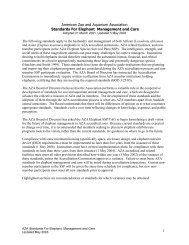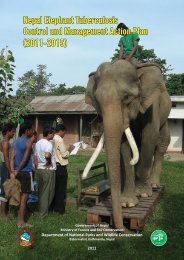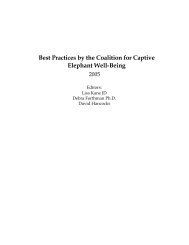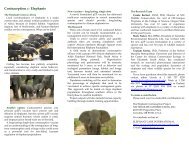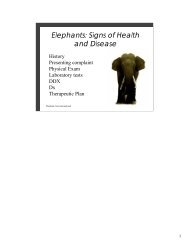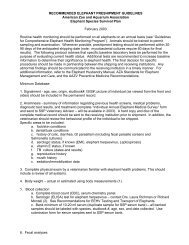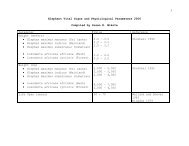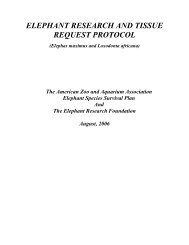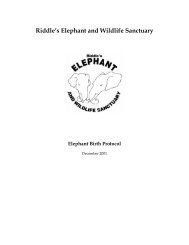Elephant Tuberculosis Research Workshop - Elephant Care ...
Elephant Tuberculosis Research Workshop - Elephant Care ...
Elephant Tuberculosis Research Workshop - Elephant Care ...
You also want an ePaper? Increase the reach of your titles
YUMPU automatically turns print PDFs into web optimized ePapers that Google loves.
Summary<br />
<strong>Elephant</strong> <strong>Tuberculosis</strong> <strong>Research</strong> <strong>Workshop</strong><br />
Orlando, FL May 21-22, 2005<br />
Contents:<br />
Background<br />
I. Brief History of <strong>Elephant</strong> <strong>Tuberculosis</strong><br />
II. Diagnostic Testing for <strong>Tuberculosis</strong> in <strong>Elephant</strong>s<br />
A. Culture and MTD (nucleic acid amplification test)<br />
B. ELISA (Enzyme-linked immunosorbent assay)<br />
C. PCR<br />
D. Rapid Test, MAPIA (MultiAntigen Print ImmunoAssay), and Immunoblot<br />
E. Other Diagnostic Tests<br />
III. Therapeutic Issues for <strong>Tuberculosis</strong> in <strong>Elephant</strong>s<br />
A. Current Anti-<strong>Tuberculosis</strong> Therapy and Adverse Effects<br />
B. Clinical Experiences with <strong>Tuberculosis</strong> and Effectiveness of Treatment in<br />
<strong>Elephant</strong>s<br />
C. New Compounds in the Anti-TB Arsenal<br />
IV. <strong>Workshop</strong> Recommendations<br />
A. Diagnostics Working Group Recommendations<br />
B. Therapeutics Working Group Recommendations<br />
Appendix I List of participants<br />
Appendix II Abbreviations and definitions<br />
Appendix III Guidelines for the Control of <strong>Tuberculosis</strong> in <strong>Elephant</strong>s (2003) - link<br />
Appendix IV Bibliography of articles pertinent to elephant TB<br />
________________________________________________________________<br />
Background: This document represents the summary findings of an <strong>Elephant</strong><br />
<strong>Tuberculosis</strong> <strong>Research</strong> <strong>Workshop</strong> organized by Susan Mikota, DVM of <strong>Elephant</strong><br />
<strong>Care</strong> International (www.elephantcare.org) and Michele Miller, DVM, PhD, the<br />
Veterinary Advisor to the AZA <strong>Elephant</strong> SSP/TAG.<br />
1
The goals of this workshop were to 1) assess the status of experimental<br />
diagnostic tests; 2) evaluate experience gained from elephants that have been<br />
treated for TB; and 3) identify specific areas of research that will advance our<br />
knowledge of the diagnosis and treatment of TB in elephants.<br />
Specific objectives:<br />
• Review data pertaining to existing diagnostic tests<br />
• Discuss experimental diagnostic tests and make recommendations regarding<br />
their validation<br />
• Determine criteria for appropriate interpretation of experimental serologic data<br />
based on scientific principles<br />
• Assess whether atypical mycobacterial infection(s) may impact diagnostic<br />
results<br />
• Identify the goal of treatment in elephants – “cure” versus cessation of<br />
shedding<br />
• Reevaluate current therapeutic regimens for elephants<br />
• Investigate the effect of treatment on diagnostic test results<br />
• Discuss means to improve our knowledge of the pathophysiology and<br />
epidemiology of TB in elephants<br />
Participants included veterinarians with experience in the treatment of TB in<br />
elephants, regulatory representatives, mycobacterial researchers, and an M.D. with<br />
human TB expertise. A list of participants is included in Appendix I. All participants<br />
were given an opportunity to review and comment on this summary document.<br />
Participants provided an update on their research or areas of expertise and were<br />
then divided into two working groups (Diagnostics and Therapeutics). Each working<br />
group was charged with identifying specific “next steps” needed to improve the<br />
diagnosis and treatment of elephant TB.<br />
A synopsis of the information presented is included in this document followed by the<br />
summary recommendations of the Diagnostics Working Group and the Therapeutics<br />
Working Group.<br />
Note: The current Guidelines for Control of <strong>Tuberculosis</strong> in <strong>Elephant</strong>s (2003) remain<br />
in effect. The Guidelines specify the trunk wash culture as the recognized diagnostic<br />
test for elephants and strongly recommend the submission of samples for ancillary<br />
testing (Section 4 Ancillary Screening / Diagnostic Tests). At this time all samples for<br />
ancillary diagnostic testing should be submitted to Dr. Michele Miller. A submission<br />
form can be found at the following link:<br />
http://www.elephantcare.org/protodoc_files/new03/<strong>Elephant</strong>%20Serum%20Bank%2<br />
0Submission%20Form.pdf<br />
2
Based on the findings of this <strong>Workshop</strong> and the collection of additional data, a<br />
subsequent meeting is planned for early 2006 to review specific recommendations<br />
for potential changes to the Guidelines.<br />
Definitions: See Appendix II for abbreviations and definitions used in this report.<br />
Note that Mycobacterium tuberculosis and Mycobacterium bovis are collectively<br />
referred to as TB.<br />
References: See Appendix IV for a bibliography of articles pertaining to elephant TB.<br />
I. Brief History of <strong>Tuberculosis</strong> in <strong>Elephant</strong>s<br />
Ancient treatises suggest that tuberculosis may have been detected as early<br />
as 2000 years ago in Asian elephants. The first zoo elephant reportedly affected by<br />
TB was an Indian elephant that died at the London Zoo in 1875. Additional cases<br />
appeared in the literature in the early 20 th century. The first case of mycobacterial<br />
infection in an African elephant was reported in the 1960’s.<br />
Although additional cases were reported sporadically, tuberculosis “emerged”<br />
as a disease of concern for elephants in 1996 when two elephants from a privatelyowned<br />
traveling herd died from the disease. This diagnosis in 1996 raised public<br />
concern for elephant and human health. In response the USDA formed an advisory<br />
panel to establish diagnostic and treatment protocols for the remaining elephants in<br />
the herd. The following year, five new elephant cases were identified. This prompted<br />
the development of protocols for the surveillance of all elephants. In 1998, the USDA<br />
and National <strong>Tuberculosis</strong> Working Group for Zoo and Wildlife Species released the<br />
first Guidelines for the Control of TB in <strong>Elephant</strong>s, which were published as Policy 21<br />
under the Animal Welfare Act. These guidelines established culture as the<br />
recommended test for the diagnosis of TB in elephants, and classified elephants into<br />
groups based on culture results and exposure history.<br />
During this time, treatment regimens were being developed and tested.<br />
Based on changes in the knowledge base of TB in elephants, the Guidelines were<br />
revised in 2000 and again in 2003. Major changes in the last revision included the<br />
requirement that drugs be directly administered, rather than given free choice in<br />
food. Target serum drugs levels were established and treatment regimens and<br />
options were updated<br />
Between 1994 and June 2005, there were 34 confirmed cases of tuberculosis<br />
in elephants in the U.S. population. Thirty one Asian and three African elephants<br />
were affected. Mycobacterium tuberculosis was the etiologic agent in 33 cases and<br />
M. bovis in one case. Three cases of tuberculosis caused by unusual nontuberculous<br />
mycobacteria are excluded from this discussion. Twenty-two of the 34<br />
cases were diagnosed antemortem on the basis of cultures obtained by trunk<br />
washes or swabs and 12 cases were diagnosed postmortem. The majority of<br />
elephants, including the 12 cases diagnosed at post-mortem, did not show clinical<br />
signs suggestive of TB. Of the 34 cases, 19 have died or were euthanized. In some<br />
cases TB was an incidental finding at necropsy and was not considered the cause of<br />
death.<br />
3
The zoonotic potential for the spread of TB between elephants and humans<br />
has been documented in one case (Michalak et al. 1998). Other reports have<br />
demonstrated epizootic spread of the same strain of M. tuberculosis between<br />
elephants and other zoo mammals (Oh, et al. 2002).<br />
Currently, the diagnosis of TB in elephants remains a dilemma. The<br />
sensitivity of trunk wash culture, the currently recommended test for diagnosis, is<br />
unknown. False negatives have been documented (trunk wash negative elephants<br />
that were subsequently found to be culture positive at necropsy). Although unlikely,<br />
false positive results may also occur due to incorrect labeling of specimens at the<br />
time of collection; cross contamination of specimens has been documented using<br />
older microbiologic growth systems but appears to be decidedly rare at present.<br />
Other non-culture techniques for TB diagnosis include ELISA, PCR, gamma<br />
interferon (under development), and lymphocyte stimulation (not available at this<br />
time). Serologic or other indirect assays (that detect antibodies but not the actual<br />
organism) may not be able to differentiate among 1) animals that are infected and<br />
shedding 2) animals that are infected and not shedding and 3) non-infected animals<br />
that were previously infected. Potential future diagnostic tests might utilize those<br />
being developed for human patients.<br />
Similar to diagnostic issues, treatment parameters are still under<br />
investigation. Effective drug levels for elephants have not been determined<br />
however, levels known to be effective in humans have been achieved in elephants.<br />
Adverse drug effects have been a significant issue for some elephants. Long-term<br />
medication administration is challenging in this species, and there is currently no<br />
pre-mortem method to confirm a cure. However, there are a number of new antituberculosis<br />
drugs being developed for humans that may be more effective or have<br />
fewer side effects. Other routes and treatment regimens (route and frequency)<br />
could also be explored for future treatment options.<br />
II. Diagnostic Testing for <strong>Tuberculosis</strong> in <strong>Elephant</strong>s<br />
A. Culture and MTD (nucleic acid amplification test)<br />
A summary of culture results shows that TB has been isolated from 34 captive<br />
elephants in 15 herds in 8 different states between1994-June 2005 (includes one<br />
case of M. bovis). In three cases, M. tb recurred following initial treatment. Isolates<br />
from 12 elephants showed resistance to some anti-TB drugs.<br />
Trunk wash samples may be submitted to any microbiologic laboratory capable<br />
of culturing for mycobacteria. Over the period 1997-2005, 8715 trunk washes or<br />
swabs were submitted to National Veterinary Services Laboratories (NVSL) that<br />
yielded 423 different mycobacterial isolations. Mycobacterium avium, a nontuberculous<br />
mycobacterium, was the most prevalent mycobacterial species detected<br />
(Table 1). As with humans, infection with non-tuberculous mycobacteria (NTM) is not<br />
considered to represent a public health risk or a risk to other animals. Moreover,<br />
there is no data to suggest that NTM are communicable, i.e. spread from animal to<br />
animal or animal to human.<br />
DNA fingerprinting (RFLP) of some of the elephant isolates has identified 7<br />
different strains of M. tuberculosis. These were found in 6 different areas of the<br />
country. Animals from the same facilities often had identical or similar RFLP<br />
4
profiles, which suggested transmission of infection among the elephants or a<br />
common source of infection. However, one facility had 4 elephants with 3 unique<br />
strains of M. tb. In one facility, two out of five culture-positive elephants were found<br />
to have two different strains of M. tb each.<br />
NVSL has also performed over 1100 Gen Probe MTDs (a nucleic acid<br />
amplification test). The Gen Probe MTD is approved by the FDA for the diagnosis of<br />
TB from human sputum and bronchial specimens and tracheal aspirates; the test<br />
does not differentiate between the presence of M. tuberculosis or M. bovis. A total<br />
of 72 submitted specimens were MTD positive. Of the 72 positive samples, M. tb<br />
was isolated by culture from 13 samples; 28 samples had suspect cultures (6 with<br />
Mycobacterium sp. not otherwise identified). There were 1000 MTD negative<br />
samples from which M. tb was cultured from 6 samples. Therefore, this test<br />
identified 13 culture positive elephants correctly. It also correctly identified the M.<br />
bovis elephant. However, there were MTD positive elephant samples from which M.<br />
tb was not isolated by culture and six MTD negative elephants had a positive M. tb<br />
culture.<br />
Of the 34 culture positive elephants, 22 have been treated. Three of the 22 were<br />
treated twice. One of the re-treated elephants was an early case in which anti-TB<br />
drugs were given ad lib over food, a method that is no longer considered adequate.<br />
In a survey of antibiotic resistance of 19 elephants at 10 facilities that included 34<br />
isolates of M. tb and 1 isolate of M. bovis, it was found that 9/34 strains (26.5%)<br />
were resistant to at least one antibiotic (Harris and Osorio, NVSL) (Table 2). Human<br />
TB drug resistance is reported to be approximately 10%. Similar to humans,<br />
elephant isolates were most commonly resistant to isoniazid and rifampin. Multidrug<br />
resistance (defined as resistance to two or more first line anti-TB drugs) was<br />
observed in two elephant isolates at NVSL.<br />
In summary, the RFLP profiles showed that multiple strains of M. tuberculosis<br />
were recovered from geographically unrelated elephants. This suggests that there<br />
were several sources of infection rather than a single index case spreading to<br />
multiple elephants. The emergence of drug-resistant strains may be associated with<br />
inadequate antibiotic treatment.<br />
B. ELISA (Enzyme-linked immunosorbent assay)<br />
Earlier versions of this assay incorporated multiple antigens, including a six<br />
antigen panel from M. bovis (CF, PPD, MPB 70), M. tuberculosis (ERD, RA), and M.<br />
avium (AVPPD). Except for MPB 70, all represent antigen pools of culture filtrate<br />
(CF), purified protein from the culture filtrate (PPD-bovis), or protein mixtures from<br />
pathogenic human M. tuberculosis strains Erdman and H37Ra. Sera from Asian<br />
elephants that were culture positive for M. tuberculosis by trunk wash were used as<br />
positive samples. No treatment was administered prior to sampling (n=7). Negative<br />
samples were obtained from 25 Asian and 15 African elephants. Criteria were a<br />
negative trunk wash culture within 3 months of serum sample, no contact with known<br />
TB positive elephants, and no movement outside the holding institution within the<br />
last 5 years. Also, no intradermal tuberculin test had been administered to either<br />
group within 6 months prior to sampling (Larsen et al. 2000).<br />
5
Differences in seroreactivity were observed between infected and non-infected<br />
elephants for all antigens except MPB70. In addition, there were differences in<br />
seroreactivity in non-infected Asian and African elephant samples for CF, PPD,<br />
ERD, and AVPPD. Using CF + RA in the ELISA, the specificity and sensitivity of the<br />
test were 100% for detecting culture positive elephants. (See Appendix II for<br />
definitions of sensitivity and specificity). When a small number of elephants had<br />
intradermal skin tests, it appeared that some had a change in seroreactivity. There<br />
also appeared to be a change in seroreactivity with treatment in some elephants.<br />
A modified ELISA using six antigens has been recently tested (M bovis – CF,<br />
MPB70; M tb - ESAT6, Ag85, MPT64, MTP32). Using this assay a group of 25<br />
Asian elephants were tested, 6 culture positive and 19 culture negative, based on<br />
the criteria above. Antigens that appeared to discriminate between culture positive<br />
and negative samples were CF, MPB70 and ESAT6. An expanded study was<br />
performed with 68 Asian elephants, including 16 culture positive animals. Using CF<br />
+ ESAT6, the specificity was 100% and sensitivity was 94% (one culture positive<br />
elephant showed no seroreactivity). Therefore, this ELISA correctly classified 67 out<br />
of 68 elephants tested. ELISA was capable of differentiating infected elephants<br />
earlier than culture (months-years).<br />
C. PCR (polymerase chain reaction)<br />
Studies are underway to examine the ability to detect mycobacterial organisms in<br />
trunk wash samples using PCR. Currently, experiments have been performed using<br />
M. bovis spiked trunk wash. The test method has detected concentration of 100<br />
organisms/100 ul of sample. Additional work needs to be performed to determine<br />
sensitivity of the assay and run PCR on trunk washes from known TB infected<br />
elephants.<br />
D. Rapid Test, MAPIA (MultiAntigen Print ImmunoAssay), and Immunoblot<br />
One company, Chembio, has developed two tests for the diagnosis of TB in<br />
animals. The Rapid test (RT) is an immunoassay based on lateral-flow technology.<br />
Nitrocellulose membranes are impregnated with test antigens in a single test strip as<br />
a screening test with relatively high sensitivity but lower specificity. The MAPIA<br />
assesses the presence of antibodies to ~10 individual mycobacterial antigens. The<br />
RT and MAPIA are developed as screening and confirmatory tests similar to current<br />
technologies in use for HIV testing.<br />
The RT uses a mixed grouping of selected mycobacterial antigens using an<br />
automatic printing device. Strips are laminated with sample pad, conjugate pad and<br />
sink pad, and placed into plastic cassettes similar to a pregnancy test kit. The test<br />
employs a blue latex-based antibody detection system using antigen-coupled<br />
particles. Thirty microliters of elephant serum, plasma, or fresh whole blood is placed<br />
onto the sample pad, and three drops of diluent are added. Test results can be read<br />
within 20 minutes. A blue band of any intensity observed in the test window is<br />
considered a positive result while no visible band in the test window is a negative<br />
result. A control line developed in the control window will appear irrespective of the<br />
presence of specific antibody in the sample to confirm that the test is performed<br />
properly (Figure 1).<br />
6
The MAPIA uses 10 purified recombinant antigens of M. tuberculosis (ESAT-6,<br />
CFP10, MPB59, MPB64, MPB70, MPB83, alpha-crystallin, 38 kDa protein, Mtb8,<br />
Mtb48), 3 polyprotein fusions (TBF10, CFP10/ESAT-6, and Acr1/MPB83), and<br />
culture filtrates of M. bovis that are separately immobilized on a nitrocellulose<br />
membrane using a semi-automated airbrush-printing device. The membrane is cut<br />
into strips, which are incubated with elephant serum samples. After incubation with<br />
elephant serum (or whole blood), antibodies bound to printed antigens are visualized<br />
using a species-nonspecific conjugate (Figure 2). Antigen for the immunoblot is<br />
a whole cell sonicate (WCS) of M. bovis that is separated on polyacrylamide gel and<br />
transferred to nitrocellulose membranes. Similar to MAPIA, these membranes are<br />
incubated with elephant serum then visualized using a detection reagent.<br />
Multiple serum samples collected from 90 Asian and African elephants in<br />
Europe, South Africa, and the U.S. have been tested using the MAPIA and RT. Of<br />
these, 17 were culture-positive for M. tuberculosis (or M. bovis in one African<br />
elephant) (Table 3). Of 63 culture negative control elephants with finalized status<br />
(healthy or other disease), one was reactive with RT but not MAPIA (this animal had<br />
a chronic osteomyelitis). The antibody responses in culture positive elephants to<br />
individual antigens demonstrated that the immunodominant antigens were ESAT-6<br />
(100% sensitivity) and CPF10 (75%). Overall, with this test population, the Rapid<br />
Test showed 100% sensitivity and 98% specificity; the MAPIA had 94% sensitivity<br />
and 100% specificity.<br />
Using the Rapid Test, MAPIA, and immunoblot, sera were tested from known<br />
culture positive elephants over time to examine the development of the serologic<br />
response. Individual antibody responses showed that all three assays could detect<br />
seroconversion years prior to the first positive culture in a number of infected<br />
elephants. In one epidemiological study, it was demonstrated that in a group of 5<br />
infected elephants (confirmed at necropsy), there were only 6 positive cultures out of<br />
59 trunk wash samples. One elephant never had a positive trunk wash culture and<br />
was diagnosed at necropsy. However, retrospective evaluation of serum from this<br />
elephant showed positive results on the Rapid Test-as long as 8 years prior to<br />
euthanasia.<br />
These assays were also used to test sera from culture positive elephants<br />
before, during, and after treatment for tuberculosis. The pattern of antigen<br />
seroreactivity in MAPIA and immunoblot changed as treatment was initiated, and in<br />
those elephants with recrudescence, a rise in titer to specific antigens was also<br />
detected.<br />
Serum from two elephants infected with Mycobacterium szulgai, were positive<br />
on RT, but had distinctive MAPIA patterns from those observed with M. tb culture<br />
positive elephants.<br />
These serological studies produced two important observations. First, with all<br />
elephant TB cases where retrospective samples were available for testing, the<br />
antibody responses could be detected much earlier (2 to 6 years) than positive<br />
cultures from trunk washes were first documented. Moreover, in some instances,<br />
culture was positive only at necropsy (consistently negative from trunk washes)<br />
while serology indicated TB infection occurred years earlier. Second, when TBinfected<br />
elephants were under treatment, the antibody titers to certain antigens used<br />
7
in MAPIA declined quickly to baseline levels, apparently in response to therapy.<br />
Thus, MAPIA may potentially be used for early diagnosis, and also for monitoring<br />
response to treatment. This was also shown in some cases with ELISA as well.<br />
Further research is needed to validate these tests and determine the sensitivity<br />
and specificity (the true rate of false positive and false negative test results) using<br />
the RT and MAPIA. In particular, these tests have not been sufficiently evaluated in<br />
herds with a low pre-test probability of a positive test (where false positives are more<br />
likely). For animals with recent exposures, the time to develop a positive RT or<br />
MAPIA test result (i.e., the time to seroconversion) is unknown. Additionally, the<br />
lower level of detection of latent infection is unknown. For example, will the RT and<br />
MAPIA detect disease that is isolated to a single lymph node?<br />
E. Other Diagnostic Tests<br />
At this time, other diagnostic tests have not been tested or are not currently<br />
available for use in elephants. A gamma interferon assay (that measures induction<br />
of gamma interferon by peripheral blood mononuclear cells of tested animals) is<br />
being developed for use in elephants, but it is not expected to be available for at<br />
least another few years. The BTB assay (a combination of lymphocyte stimulation<br />
and seroreactivity against bovine PPD) is no longer available.<br />
Overview of Diagnostic Tests<br />
The ELISA, Rapid Test, MAPIA, and immunoblot detect antibodies in elephant<br />
sera to mycobacterial antigens; therefore, they provide indirect evidence of infection<br />
or exposure. Data presented suggest that these assays may be used to detect<br />
seropositive elephants months to years before a trunk wash or necropsy culture is<br />
positive. Patterns of seroreactivity may also be useful for monitoring response to<br />
treatment. Since the RT detects seroreactivity to all target antigens simultaneously<br />
and therefore cannot distinguish the pattern of seroreactivity, it would best be used<br />
as a screening test, with the MAPIA and/or ELISA as a confirmatory test. PCR of<br />
trunk wash samples has not been tested with field samples, but may provide another<br />
method of organism detection. Recent work by Sloutsky et al (2004) has determined<br />
that dilution of clinical specimens 1:10 increases the sensitivity of the MTD in human<br />
samples. Whether similar increases in test performance can be realized for<br />
elephant samples is unknown. Definitive diagnosis of infection still requires<br />
identification of the mycobacterial organism, usually by culture. Culture is essential<br />
to determine antibiotic sensitivity patterns and the selection of drugs that will be used<br />
for treatment.<br />
STATUS: Culture of trunk wash samples is the only test currently required by the<br />
Guidelines for the Control of <strong>Tuberculosis</strong> in <strong>Elephant</strong>s 2003. All other tests<br />
discussed in this document are considered ancillary tests at this time and further<br />
work is needed for validation.<br />
8
III. Therapeutic Issues for <strong>Tuberculosis</strong> in <strong>Elephant</strong>s<br />
A. Current Anti-<strong>Tuberculosis</strong> Therapy, and Adverse Effects<br />
Commonly used drugs for treatment of tuberculosis in elephants include isoniazid<br />
(INH), rifampin (RIF), pyrazinamide (PZA), and ethambutol (EMB). Consult the<br />
Guidelines for current recommended dosages and routes of administration. Initial<br />
empirical therapy has usually included INH, RIF and PZA. Drug resistance has been<br />
identified to INH and RIF. This may necessitate treatment regimens with limited<br />
choices of remaining first line agents (PZA, EMB), inclusion of second line agents) or<br />
the use of drugs for which there is significantly less clinical data (e.g. enrofloxacin or<br />
other quinolone antibiotics). See below for more details regarding treatment<br />
regimens.<br />
Multiple clinicians have experienced similar problems in the treatment of TB in<br />
elephants. <strong>Elephant</strong>s can be discerning eaters and difficult to treat orally, especially<br />
long-term. Direct oral administration appears to achieve slightly higher blood levels<br />
than the rectal route, and oral administration over food fed ad lib is no longer<br />
recommended. However, elephants can be trained to accept a bite block for oral<br />
administration with an equine dosing syringe. Some drugs, such as amikacin, can<br />
only be given by injection. In one case, this drug was formulated at a higher<br />
concentration to decrease the volume injected intramuscularly.<br />
Other issues are cost and availability of drugs. It was estimated that the cost of<br />
treating a single elephant was $50-60,000. Drug costs based on the recommended<br />
dosages for an adult Asian elephant were roughly $5/day for INH, $65/day for RIF,<br />
$190/day for PZA, and $155/day for EMB. Since therapy requires multiple drugs to<br />
be given, the costs can vary but are substantial. The other issue is the quantity and<br />
availability of drugs. Often bulk drug is used and obtaining this in adequate<br />
quantities may cause interruption in treatment.<br />
Signs of toxicity in treated elephants were commonly seen and usually<br />
associated with INH. These included weakness, ataxia, anorexia, elevated liver<br />
enzymes, pica, and sand consumption. Clinical signs usually resolved with a<br />
reduction in dosage, stopping medication for a period of time, or using “pulse”<br />
therapy (ex. treating three times a week at double the dosage). It was often difficult<br />
to reach therapeutic blood levels without inducing toxicity, and there appeared to be<br />
individual variation between and within elephants on the same treatment regimen.<br />
Since elephants are usually treated with multi-drug therapy for tuberculosis or<br />
prophylaxis, it is often difficult to determine which specific drug may be responsible<br />
for the clinical signs associated with toxicity. In one group of elephants treated<br />
prophylactically with enrofloxacin at 10 mg/kg PO SID and PZA at 30 mg/kg PO SID,<br />
clinical signs of inappetance, increased epiphora, and blepharitis were seen in the<br />
majority of individuals, with corneal edema and limb stiffness observed in half the<br />
group. One individual treated with PZA, EMB, enrofloxacin and amikacin developed<br />
anorexia, weakness, ataxia, and trunk paralysis/paresis. Another individual treated<br />
with INH and PZA developed anemia (decreased hematocrit, RBC count, and<br />
hemoglobin concentration), which resolved about 4 weeks after reduction in dosages<br />
of both drugs. Discussion with a pharmacist during this period indicated that INH<br />
and PZA both affect bone marrow RBC stem cells but through different pathways.<br />
9
Complete blood count (CBC) and serum chemistry panels are recommended<br />
monitoring tools for elephants receiving anti-tuberculosis drugs. Elevated hepatic<br />
enzymes were commonly associated with clinical signs. Common human side<br />
effects of anti-tuberculosis drugs are shown in Figure 3.<br />
B. Clinical Experiences with <strong>Tuberculosis</strong> and Effectiveness of Treatment<br />
in <strong>Elephant</strong>s<br />
Similar to the information presented in the diagnostic section, veterinarians that<br />
have worked with TB-infected elephants have found culture to be a specific but<br />
insensitive method of diagnosing tuberculosis in elephants. Some elephants that<br />
had pulmonary pathology and from which mycobacteria were isolated at necropsy<br />
had histories of multiple negative trunk washes. Other elephants had variable<br />
numbers of negative trunk wash cultures (up to 54) before having a positive<br />
isolation. In one elephant with uterine mycobacteriosis, culture of vaginal discharge<br />
still only yielded positive isolation in 28.6% of the samples, with lower recovery from<br />
other sites.<br />
Approximately 22 culture positive elephants have received anti-tuberculosis<br />
treatment to date. Based on serial cultures, elephants, like humans, appear to<br />
cease shedding within weeks of the initiation of treatment. Can TB be cured in<br />
elephants? Three elephants that were treated for TB and subsequently died or were<br />
euthanized were found to be culture negative at postmortem examination. Two other<br />
treated elephants were culture positive at necropsy. One of these was the 1996<br />
index case. This elephant was not considered to have been adequately treated. The<br />
initial treatment was given with medications administered over food (prior to the<br />
change in the Guidelines) and variable drug levels were achieved. The elephant was<br />
treated a second time but again, treatment was not considered adequate and may<br />
not have followed prescribed Guidelines. The other case was an elephant that was<br />
under treatment for multi-drug resistant TB. This elephant was euthanized. Since<br />
only a few of the treated animals have died or been euthanized, it may be difficult to<br />
determine whether treatment has eliminated infectious organisms or just suppressed<br />
shedding.<br />
C. New Compounds in the Anti-TB Arsenal<br />
The current first line agents for tuberculosis treatment in humans are isonicotinic<br />
acid hydrazide (INH), rifampin (RIF), pyrazinamide (PZA), ethambutol (EMB), and<br />
streptomycin (SM). Second line agents are capreomycin, amikacin, ethionamide<br />
(ETH), para-aminosalacylic acid (PAS), and the fluroquinolones (ciprofloxacin,<br />
levofloxacin, moxifloxicin). Multi-drug resistant (MDR) TB occurs in approximately 5-<br />
10% of cases worldwide, with the highest incidence in Russia, China, Mexico,<br />
Vietnam, and Haiti. It is most common among low socioeconomic groups and<br />
patients with poor treatment adherence. INH or RIF resistance is more prevalent at<br />
approximately 20%.<br />
Human empiric treatment regimens for TB are determined by the prevalence of<br />
TB in the local population. In areas where MDR-TB is less than 1%, a three drug<br />
treatment using INH, RIF, and PZA is used. If the prevalence of MDR-TB is 1-5%, a<br />
four drug cocktail is used with INH, RIF, PZA, and EMB. When the prevalence of<br />
10
MDR-TB is greater than 5%, a fifth drug is added to the above combination, usually<br />
streptomycin or a fluoroquinolone. When the susceptibility of a human TB isolate<br />
has been determined, treatment length and drug combination is based on this<br />
information (Figure 4).<br />
Newer agents include the fluoroquinolones, such as gatifloxacin, levofloxacin,<br />
moxifloxacin, ciprofloxacin, and ofloxacin. These drugs have synergistic activity with<br />
INH and ethionamide. In clinical trials of small numbers of patients those for whom,<br />
moxifloxacin was added to their anti-tuberculous regimen sterilized quicker and had<br />
fewer relapses with less hepatitis than standard treatments.<br />
Linezolid is a newer drug that is a combination of quinopristine and<br />
dalfinopristine. It is synergistic with rifampin and has been used to treat MDR cases.<br />
Although the MIC is
IV.<br />
<strong>Workshop</strong> Recommendations<br />
Based on the information presented, the current knowledge and future direction<br />
of diagnostic testing and treatment of tuberculosis in elephants was discussed.<br />
Concerns for the public health and regulatory consequences were taken into<br />
consideration. The past approximately 10 years of work in this field has yielded<br />
significant progress but there remain many gaps in knowledge regarding the<br />
pathobiology of the disease in elephants. In order to address some of the most<br />
immediate practical issues facing diagnosis and treatment, the following<br />
recommendations and action plans were developed.<br />
A. Diagnostics Working Group Recommendations<br />
In order to coordinate sample and data collection, it is recommended<br />
that serum samples continue to be sent through the <strong>Elephant</strong> SSP/TAG<br />
Serum Bank, to create a reference bank and provide sample availability to all<br />
researchers for test validation and data analyses. In addition, all elephants<br />
that die or are euthanized should receive a thorough necropsy and<br />
mycobacterial culture per SSP recommendations (see necropsy protocol at<br />
www.elephantcare.org).<br />
1. Correlate retrospective and future necropsy data with diagnostic test results<br />
and clinical history (culture, serologic tests, PCR, gross lesions,<br />
histopathology, and presence of acid-fast bacilli).<br />
a. Request sera from previous cases for testing.<br />
b. Obtain copies of necropsy reports and other lab data as needed.<br />
c. Recommend thorough necropsy on ALL elephants with data collected<br />
as outlined above. Reinforce the existing recommendation of the<br />
<strong>Elephant</strong> SSP and the Guidelines that all elephants that die undergo a<br />
thorough necropsy.<br />
d. Formation of necropsy teams to facilitate process.<br />
2. Collate data collected through designated individual/group.<br />
a. See statement above regarding <strong>Elephant</strong> SSP/TAG Serum Bank.<br />
3. Perform data validation and comparison for currently available assays<br />
(ELISA, RT, MAPIA)<br />
a. Will need to segregate data for statistical analyses (M. bovis vs M. tb<br />
vs other mycobacteria; African vs Asian elephants).<br />
b. Calculate sensitivity, specificity, positive and negative predictive values<br />
of each test (and possibly tests in series).<br />
4. Ensure that all participating research labs have access to same serum<br />
sample set.<br />
5. Create a set of reference sera (“positive” and “negative”) that can be used to<br />
validate future assays.<br />
a. Ideally, “negative” samples would be from necropsy negative animals<br />
(culture and histopathology). However, for these purposes, serum<br />
from any elephant found negative in all 3 serologic tests and culture<br />
negative, with no contact with a known TB elephant for 5 years, would<br />
be considered negative.<br />
12
6. Recommend that all elephants have ante-mortem annual trunk wash cultures<br />
(triple samples) and serum be collected at the same time as trunk wash for<br />
ELISA/RT/MAPIA and for serum banking.<br />
a. Current Guidelines already strongly recommend serum collection for<br />
ancillary testing; this is not a mandated change.<br />
b. Recommend that any mycobacterial isolate from trunk wash or other<br />
site cultures that are not performed at NVSL, be sent to NVSL as a<br />
repository for future studies (epidemiology, etc.).<br />
7. Perform retrospective epidemiological review of culture positive elephants<br />
using validated serological or antigen tests.<br />
8. Recommend further studies of the pathobiology of mycobacterial infections<br />
including, M. szulgai and other non-TB mycobacterial infections in elephants<br />
a. Retrospective review of cases.<br />
b. Obtain sera from previous cases for serologic testing.<br />
c. Review list of elephants that have had atypical mycobacteria (MOTT)<br />
isolated from trunk washes.<br />
d. Obtain sera for serologic testing, if possible, to study the impact of<br />
exposure/infection on serologic results.<br />
e. Review case history for possible correlation with clinical signs or<br />
pathology.<br />
9. Request speciation of ALL mycobacteria isolated from elephants.<br />
10. Recommend frequent serum collection of treated elephants for serologic<br />
monitoring (at least every 6 months, or more frequently).<br />
B. Therapeutics Working Group Recommendations<br />
1. Investigate new routes of treatment, such as transdermal, inhalation.<br />
2. Review current TB drug therapy in elephants.<br />
a. Review current treatment regimens and consider individualizing drug<br />
levels by determining peaks at 1,2,4,6 hours for each drug (The current<br />
Guidelines specify serum drug levels be tested at 2 hours).<br />
b. Collate successful treatment regimens (such as pulse therapy) for<br />
reference for others.<br />
3. Create information sheet regarding clinicopathologic changes associated with<br />
drug toxicities.<br />
a. Provide information regarding drug adverse effects, what to monitor,<br />
how to treat, and what drugs can be substituted or how treatment regimen<br />
can be changed.<br />
b. Toxicity trial of PZA.<br />
4. Investigate new TB drug options for elephants.<br />
5. Pilot pharmacokinetic studies.<br />
a. Compare commercial ethambutol to bulk product in terms of rectal<br />
irritation.<br />
b. Pilot pharmacokinetic study of rectal rifampin.<br />
c. Pilot pharmacokinetic study of amikacin at TB dose IM.<br />
13
d. Pilot a transdermal pharmacokinetic study with amikacin or other drugs<br />
that have limited routes of administration (ETH, RIF).<br />
6. Recommend using serologic tests (ELISA, +/-RT, MAPIA) to monitor treated<br />
elephants every 3-6 months, along with culture.<br />
a. Create a database of treated elephants to include date of first positive<br />
culture, treatment dates and regimens, adverse effects, drug resistance,<br />
recurrence, etc.<br />
14
Table 1. Number of elephant samples with mycobacterial isolates 1994-<br />
2005<br />
Mycobact. species # samples<br />
Mycobact. # samples<br />
species<br />
M. species a 114 M. gastri 2<br />
M. avium 142 M. chitae 3<br />
M. tuberculosis 35 M.<br />
3<br />
scrofulaceum<br />
M. terrae complex 9 M. phlei 2<br />
M. gordonae 6 M. xenopi 2<br />
M. fortuitum 7 M. szulgai 3<br />
M. tb complex 2 M. bovis 1<br />
M. ulcerans 2 RG IV 5<br />
M. smegmatis 2 M. interjectum 2<br />
(J. Payeur, NVSL)<br />
a Early culture samples and some isolates were unable to be speciated.<br />
Table 2. Antibiotic susceptibility results for 34 samples (from 19 elephants)<br />
Antibiotic<br />
Resistant isolates<br />
Streptomycin 0/34 (0%)<br />
Isoniazid 8/34 (23.5%)<br />
Rifampin 2/34 (5.9%)<br />
Ethambutol 0/34 (0%)<br />
PZA<br />
(J. Payeur, NVSL)<br />
2/34* (5.9%) (*one M. bovis)<br />
* M. bovis is inherently PZA resistant.<br />
Table 3. Serodiagnosis of tuberculosis (M. tb, M. bovis) in elephants using<br />
Rapid Test (RT) and MAPIA<br />
Culture<br />
status<br />
# elephants # positive RT # positive<br />
MAPIA<br />
Culture<br />
63 1 0<br />
negative<br />
Culture<br />
positive<br />
17 17 16<br />
(K. Lyashchenko, Chembio, Inc.)<br />
15
Figure 1. Rapid Test<br />
Figure 2.<br />
(K. Lyashchenko, Chembio, Inc.)<br />
(K. Lyashchenko, Chembio, Inc.)<br />
16
Figure 3. Common human side effects of anti-tuberculosis drugs.<br />
(G. Dumonceaux, BGT)<br />
Figure 4. Human TB treatment regimen<br />
(J. Maslow)<br />
17
Appendix I - <strong>Workshop</strong> Participants<br />
1. Wilbur Amand, VMD - Executive Director, American Association of Zoo<br />
Veterinarians<br />
2. Ray Ball, DVM - Veterinarian, Busch Gardens-Tampa<br />
3. Genevieve Dumonceaux, DVM - Veterinarian, Busch Gardens-Tampa<br />
4. Freeland Dunker, DVM - Veterinarian, San Franscisco Zoo<br />
5. Karin Hamilton, Tufts veterinary student with the Nepal <strong>Elephant</strong> Project<br />
6. Ramiro Isaza, DVM, MS, DACZM – Assistant Professor , University of<br />
Florida, College of Veterinary Medicine<br />
7. Gretchen Kaufman, DVM – Assistant Professor, Tufts Center for<br />
Conservation Medicine; Nepal <strong>Elephant</strong> Project<br />
8. Scott Larsen, DVM, MS, DACZM – Lecturer, University of California-<br />
Davis, School of Veterinary Medicine<br />
9. John Lehnhardt – General Curator Disney’s Animal Kingdom; <strong>Elephant</strong><br />
SSP/TAG Steering Committee<br />
10. Bill Lindsay, DVM, DACVS – Veterinarian, Feld Entertainment Inc.<br />
11. Konstantin Lyashchenko, PhD – <strong>Research</strong> Director of Mycobacterial<br />
Immunology, Chembio Diagnostic Systems, Inc.<br />
12. Joel Maslow, MD, PhD – Chief of Infectious Diseases VA Medical Center,<br />
Associate Vice Dean for <strong>Research</strong>, Associate Professor of Medicine in<br />
Infectious Diseases, University of Pennsylvania<br />
13. Susan Mikota, DVM – Director of Veterinary Programs and <strong>Research</strong>,<br />
<strong>Elephant</strong> <strong>Care</strong> International<br />
14. Michele Miller, DVM, PhD – Veterinarian, Disney’s Animal Programs;<br />
Veterinary Advisor to the <strong>Elephant</strong> SSP/TAG<br />
15. Richard Montali, DVM, DACVP, DACZM – University of California-Davis,<br />
Dept. of Pathology, Microbiology, Immunology<br />
16. Janet Payeur, DVM, PhD – Head, Mycobacteria and Brucella Section,<br />
USDA / APHIS / VS, National Veterinary Services Laboratories<br />
17. Dennis Schmitt, DVM, PhD, DACT – Professor, Southwest Missouri State<br />
University<br />
18. Stephen Scott, DVM – Veterinarian, The <strong>Elephant</strong> Sanctuary<br />
19. Denise Sofranko, DVM – Field Specialist for <strong>Elephant</strong>s,<br />
USDA/APHIS/Animal <strong>Care</strong><br />
20. Ray Waters, DVM, PhD – USDA / ARS - National Animal Disease Center<br />
18
Appendix II - Abbreviations and Definitions (as they apply to TB)<br />
Refer to the Guidelines for the Control of <strong>Tuberculosis</strong> in <strong>Elephant</strong>s for<br />
additional definitions.<br />
Culture positive elephant - an animal from which M. tuberculosis or M. bovis<br />
is cultured from any body site or specimen. A culture positive elephant is<br />
considered positive until 1) it has completed six months of treatment with<br />
documentation that adequate TB drug serum levels have been achieved on<br />
two separate testing dates and 2) it can be demonstrated that trunk wash<br />
cultures (obtained according to procedures outlined in the Guidelines) on at<br />
least two consecutive months are negative.<br />
Direct test – a test that detects the TB organism (e.g. MTD, culture)<br />
ELISA – Enzyme linked immunoassay; a test used to detect and measure<br />
either antigen or antibody.<br />
False positive – a test result that wrongly identifies an animal as infected<br />
False negative – a test results that wrongly identifies an animal as uninfected<br />
First line TB drugs: isoniazid, pyrazinamide, rifampin, ethambutol, and<br />
streptomycin<br />
Indirect test – a test that detects a response to the organism (e.g. antibodies)<br />
but not the organism itself<br />
MAPIA – MultiAntigen Print Immunoassay; a serological assay in which<br />
antigens are applied to a nitrocellulose membrane by micro-aerosolization<br />
(printing), followed by antibody detection using standard techniques<br />
MTB complex – consists of M. tuberculosis, M. bovis, M. bovis BCG, M.<br />
africanum, M. canetti, and M. microti<br />
Multi-drug resistant (MDR) TB – a strain of TB resistant to two or more of the<br />
first line TB drugs<br />
MTD (Gen-Probe Amplified Mycobacterium <strong>Tuberculosis</strong> Direct Test ® ) –<br />
Direct target-amplified nucleic acid probe test for the in vitro diagnostic<br />
detection of Mycobacterium tuberculosis complex rRNA in acid-fast bacilli<br />
(AFB) smear positive and negative concentrated sediments from sputum,<br />
bronchial specimens, or tracheal aspirates. FDA approved direct test for<br />
smear positive and negative specimens. MTD in smear-positive human<br />
patients has a sensitivity of 96.9% and a specificity of 100%, PPV of 100%<br />
19
and NPV of 87.5%. MTD in smear-negative human patients has a sensitivity<br />
of 72% and a specificity of 99.3%, PPV of 94.7% and NPV of 95.3%.<br />
PCR – polymerase chain reaction; a nucleic acid amplification technique in<br />
which specific sequences of DNA are replicated, allowing for detection of<br />
target sequences that otherwise would not be present in high enough<br />
numbers to be detected.<br />
Rapid Test – a quick diagnostic test for TB that uses a mixed grouping of<br />
selected mycobacterial antigens<br />
RFLP – restriction fragment length polymorphism. A technique used to<br />
determine the particular strain of TB<br />
Sensitivity – a measure of the ability of a test to identify infected animals (true<br />
positives)<br />
Specificity - a measure of the ability of a test to identify non-infected animals<br />
(true negatives)<br />
Appendix III – links to Guidelines for the Control of <strong>Tuberculosis</strong> in <strong>Elephant</strong>s<br />
(2003)<br />
http://www.aphis.usda.gov/ac/TBGuidelines2003.pdf<br />
http://www.elephantcare.org/protodoc_files/new2004/TB Guidelines 2003 Final.pdf<br />
20
Appendix IV - <strong>Elephant</strong> <strong>Tuberculosis</strong> Bibliography (www.elephantcare.org)<br />
(Articles are in chronological order with the most recently published articles listed first)<br />
1. Lewerin,S.S., Olsson,S.L., Eld,K., Roken,B., Ghebremichael,S., Koivula,T.,<br />
Kallenius,G., and Bolske,G. 2005. Outbreak of Mycobacterium tuberculosis<br />
infection among captive Asian elephants in a Swedish zoo. Vet Rec. 156(6):171-<br />
175.<br />
2. Maslow,J.N., Mikota,S.K., Zhu,M., Riddle,H., and Peloquin,CA. 2005.<br />
Pharmacokinetics of ethambutol (EMB) in elephants. J Vet Pharmacol Ther.<br />
28:321-323.<br />
3. Maslow,J.N., Mikota,S.K., Zhu,M., Isaza,R., Peddie,L.R., Dunker,F., Peddie,J.,<br />
Riddle,H., and Peloquin,CA. 2005. Population pharmacokinetics of isoniazid in<br />
the treatment of Mycobacterium tuberculosis among Asian and African elephants<br />
(Elephas maximus and Loxodonta africana). J Vet Pharmacol Ther. 28(1):1-7.<br />
4. Pandey,R. and Khuller,G.K. 2005. Antitubercular inhaled therapy:opportunities,<br />
progress and challenges. Journal of Antimicrobial Therapy 55:430-435.<br />
5. Zhu,M., Maslow,J.N., Mikota,S.K., Isaza,R., Dunker,F., and Peloquin,C.A. 2005.<br />
Population pharmacokinetics of pyrazinamide in elephants. Journal of Veterinary<br />
Pharmacology and Therapeutics. In press.<br />
6. Sloutsky, A., Han L.L. and Werner, B.G. 2004. New method for detection of<br />
Mycobacterium tuberculosis Direct Test inhibitors in clinical specimens.<br />
7. Diagn. Mictobiol Infect Dis 2004 Oct; 50(2):109-11.Guidelines for the control of<br />
tuberculosis in elephants. http://www.aphis.usda.gov/ac/TBGuidelines2003.pdf.<br />
8. Chakraborty,A. 2003. Diseases of elephants (Elephas maximus) in India-A<br />
Review. Indian Wildlife Year Book 2:74-82.<br />
9. Michel,A.L., Venter,L., Espie,I.W., and Coetzee,M.L. 2003. Mycobacterium<br />
tuberculosis infections in eight species at the National Zoological Gardens of<br />
South Africa, 1991-2001. Journal of Zoo and Wildlife Medicine 34(4):364-370.<br />
10. Pavlik,I., Ayele,W.Y., Parmova,I., Melicharek,I., Hanzlikova,M., Svejnochova,M.,<br />
and Kormendy,B. 2003. Mycobacterium tuberculosis in animal and human<br />
populations in six Central European countries during 1990-1999. Veterinarni<br />
Medicina 48(4):83-89.<br />
11. Rahman,T., 2003. Infectious and non-infectious disease of elephants. In Das,D.<br />
(Editor). Healthcare, Breeding and Management of Asian <strong>Elephant</strong>s.New Delhi<br />
Project <strong>Elephant</strong>. Govt. of India, pp. 108-118.<br />
12. Ziccardi,M., Wong,H.N., Tell,L.A., Fritcher,D., Blanchard,J., Kilbourn,A., and<br />
Godfrey,H.P. 2003. Further optimization and validation of the antigen 85<br />
immunoassay for diagnosing mycobacteriosis in wildlife. Proc Amer Assoc Zoo<br />
Vet, pp. 219-220.<br />
13. Chandrasekharan,K. 2002. Specific diseases of Asian elephants. Journal of<br />
Indian Veterinary Association Kerala 7(3):31-34.<br />
14. Mikota,S.K. and Maslow,J. 2002. Epidemiology and Treatment of <strong>Tuberculosis</strong> in<br />
<strong>Elephant</strong>s: 2002. American Association of Zoo Veterinarians Annual Conference,<br />
pp. 384-387.<br />
21
15. Oh,P., Granich,R., Scott,J., Sun,B., Joseph,M., Stringfield,C., Thisdell,S.,<br />
Staley,J., Workman-Malcolm,D., Borenstein,L., Lehnkering,E., Ryan,P.,<br />
Soukup,J., Nitta,A., and Flood,J. 2002. Human exposure following<br />
Mycobacterium tuberculosis infection of multiple animal species in a Metropolitan<br />
Zoo. Emerg Infect Dis 8(11):1290-1293.<br />
16. Payeur,J.B., Jarnagin,J.L., Marquardt,J.G., and Whipple,D.L. 2002.<br />
Mycobacterial isolations in captive elephants in the United States. Ann N Y Acad<br />
Sci 969:256-258.<br />
17. Peloquin,CA. 2002. Therapeutic drug monitoring in the treatment of tuberculosis.<br />
Drugs 62(15):2169-2183.<br />
18. Turenne,C., Chedore,P., Wolfe,J., Jamieson,F., May,K., and Kabani,A. 2002.<br />
Phenotypic and molecular characterization of clinical isolates of Mycobacterium<br />
elephantis from human specimens. J Clin Microbiol 40(4):1230-1236.<br />
19. Clifton-Hadley,R.S., Sauter-Louis,C.M., Lugton,I.W., Jacson,R., Durr,P.A., and<br />
Wilesmith,J.W., 2001. Mycobacterial diseases. In Williams,E.S. (Editor).<br />
Infectious Diseases of Wild Mammals.Ames, Iowa Iowa State University Press,<br />
pp. 340-361.<br />
20. Davis,M. 2001. Mycobacterium tuberculosis risk for elephant handlers and<br />
veterinarians. Appl Occup Environ Hyg 16(3):350-353.<br />
21. Harr,K., Isaza,R., and Harvey,J. 2001. Clinicopathological findings in<br />
Mycobacterium tuberculosis culture-positive elephants (Elephas maximus) in<br />
comparison to clinically normal elephants. Proceedings American Association of<br />
Zoo Veterinarians, American Association of Wildlife Veterinarians, Association of<br />
Reptilian and Amphibian Veterinarians and the National Association of Zoo and<br />
Wildlife Veterinarians Joint Conference 2001, pp. 209-211.<br />
22. Isaza,R. 2001. The elephant trunk wash - An update. Proc<strong>Elephant</strong> Mangers<br />
Association Annual Conference.<br />
23. Mikota,S.K., Peddie,L., Peddie,J., Isaza,R., Dunker,F., West,G., Lindsay,W.,<br />
Larsen,R.S., Salman,M.D., Chatterjee,D., Payeur,J., Whipple,D., Thoen,C.,<br />
Davis,D.S., Sedgwick,C., Montali,R., Ziccardi,M., and Maslow,J. 2001.<br />
Epidemiology and diagnosis of Mycobacterium tuberculosis in captive Asian<br />
elephants (Elephas maximus). Journal of Zoo and Wildlife Medicine 32(1):1-16.<br />
24. Montali,R.J., Mikota,S.K., and Cheng,L.I. 2001. Mycobacterium tuberculosis in<br />
zoo and wildlife species. Revue Scientifique et Technique Office International<br />
des Epizooties 20(1):291-303.<br />
25. Ratanakorn,P. 2001. <strong>Elephant</strong> Health Problems and Management in Cambodia,<br />
Lao and Thailand. A <strong>Research</strong> Update on <strong>Elephant</strong>s and Rhinos; Proceedings of<br />
the International <strong>Elephant</strong> and Rhino <strong>Research</strong> Symposium, Vienna, June 7-11,<br />
2001, pp. 111-114.<br />
26. Larsen,R.S., Salman,M.D., Mikota,S.K., Isaza,R., Montali,R.J., and Triantis,J.<br />
2000. Evaluation of a multiple-antigen enzyme-linked immunosorbent assay for<br />
detection of Mycobacterium tuberculosis infection in captive elephants. Journal of<br />
Zoo and Wildlife Medicine 31(3):291-302.<br />
27. Larsen,R.S., Salman,M.D., Mikota,S.K., Isaza,R., and Triantis,J. 2000. Validation<br />
and use of a multiple-antigen ELISA for detection of tuberculosis infections in<br />
elephants. Proc. AAZV and IAAAM Joint Conf., pp. 231-233.<br />
22
28. Lyashchenko,K., Singh,M., Colangeli,R., and Gennaro,M.L. 2000. A multi-antigen<br />
print immunoassay for the development of serological diagnosis of infectious<br />
disease. ournal of Immunological Methods 242:91-100.<br />
29. Mikota,S.K., Larsen,R.S., and Montali,R.J. 2000. <strong>Tuberculosis</strong> in <strong>Elephant</strong>s in<br />
North America. Zoo Biology 19:393-403.<br />
30. Shojaei,H., Magee,J.G., Freeman,R., Yates,M., Horadagoda,N.U., and<br />
Goodfellow,M. 2000. Mycobacterium elephantis sp. nov., a rapidly growing nonchromogenic<br />
Mycobacterium isolated from an elephant. International Journal of<br />
Systematic and Evolutionary Microbiology 50(5):1817-1820.<br />
31. Ziccardi,M., Mikota,S.K., Barbiers,R.B., and Norton,T.M. 2000. <strong>Tuberculosis</strong> in<br />
zoo ungulates:Survey results and surveillance plan. Proc. AAZV and IAAAM<br />
Joint Conf., pp. 438-441.<br />
32. Bhat,M.N., Manickam,R., and Ramkrishna,J. 1999. Screening of captive wild<br />
animals for tuberculosis. Indian Veterinary Journal 76(11):959-961.<br />
33. Biberstein,E.L. and Hirsch,D.C., 1999. Mycobacterium species: The agents of<br />
animal tuberculosis. In Veterinary Microbiology.Maiden, MA Blackwell Science,<br />
pp. 158-172.<br />
34. Isaza,R. and Ketz,C.J. 1999. A Trunk Wash Technique for the Diagnosis of<br />
<strong>Tuberculosis</strong> in <strong>Elephant</strong>s. Verh.ber.Erkrg.Zootiere 39:121-124.<br />
35. Mangold,B.J., Cook,R.A., Cranfield,M.R., Huygen,K., and Godfrey,H.P. 1999.<br />
Detection of elevated levels of circulating antigen 85 by dot immunobinding<br />
assay in captive wild animals with tuberculosis. Journal of Zoo and Wildlife<br />
Medicine 30(4):477-483.<br />
36. Mikota,S.K. 1999. Diseases of the <strong>Elephant</strong>: A Review. Verh.ber.Erkrg.Zootiere<br />
39:1-15.<br />
37. Anonymous. 1998. TB in elephants. Communique 18.<br />
38. Dunker,F. and Rudovsky,M. 1998. Management and treatment of a<br />
Mycobacterium tuberculosis positive elephant at the San Francisco Zoo.<br />
Proceedings AAZV and AAWV Joint Conference, pp. 122-123.<br />
39. Mahato,G., Rahman,H., Sharma,K.K., and Pathak,S.C. 1998. Tuberculin testing<br />
in captive Indian elephants (Elephas maximus) of a national park. Indian Journal<br />
of Comparative Microbiology, Immunology and Infectious Diseases 19(1):63.<br />
40. Michalak,K., Austin,C., Diesel,S., Bacon,M.J., Zimmerman,P., and Maslow,J.N.<br />
1998. Mycobacterium tuberculosis infection as a zoonotic disease: transmission<br />
between humans and elephants. Emerg Infect Dis 4(2):283-287.<br />
41. Montali,R.J., Spelman,L.H., Cambre,R.C., Chattergee,D., and Mikota,S.K. 1998.<br />
Factors influencing interpretation of indirect testing methods for tuberculosis in<br />
elephants. Proceedings AAZV and AAWV Joint Conference, pp. 109-112.<br />
42. Binkley,M. 1997. <strong>Tuberculosis</strong> in captive elephants. Proceedings American<br />
Association of Zoo Veterinarians, pp. 116-119.<br />
43. Essey,M.A. and Davis,J.P. 1997. Status of the National cooperative state-federal<br />
bovine tuberculosis eradication program fiscal year 1997. Proceedings United<br />
States Animal Health Association, pp. 564.<br />
44. Furley,C.W. 1997. <strong>Tuberculosis</strong> in elephants. Lancet British edition<br />
350(9072):224.<br />
23
45. Maslow,J. 1997. <strong>Tuberculosis</strong> and other mycobacteria as zoonoses. Proceedings<br />
American Association of Zoo Veterinarians, pp. 110-115.<br />
46. Mikota,S.K. and Maslow,J. 1997. Theoretical and technical aspects of diagnostic<br />
techniques for mammalian tuberculosis. Proceedings, American Association Zoo<br />
Veterinarians, pp. 162-165.<br />
47. Peloquin,CA. 1997. Using therapeutic drug monitoring to dose the<br />
antimycobacterial drugs. Clinics in Chest Medicine 18:79-97.<br />
48. Whipple,D.L., Meyer,R.M., Berry,D.F., Jarnagin,J.L., and Payeur,J.B. 1997.<br />
Molecular epidemiology of tuberculosis in wild white-tailed deer in michigan and<br />
elephants. Proceedings One Hundred and First Annual Meeting of the United<br />
States Animal Health Association, Louisville, Kentucky, USA, 18-24 October,<br />
1997, pp. 543-546.<br />
49. Dalovision,J.R., Montenegro-James,S., Kemmerly,S.A., Genre,C.F.,<br />
Chambers,R., Pankey,G.A., Failla,D.M., Haydel,K.G., Hutchinson,L.,<br />
Lindley,M.F., Praba,A., Eisenach,K.D., and Cooper,E.S. 1996. Comparison of the<br />
amplified Mycobacterium tuberculosis (MTB) direct test, aplicor MTB PCR and<br />
IS6, 110-PCR for detection of MTB in respiratory specimens. Clin.Infect.Dis.<br />
23:1099-1106.<br />
50. Moda,G., Daborn,C.J., Grange,J.M., and Cosivi,O. 1996. The zoonotic<br />
importance of Mycobacterium bovis. Tubercle and Lung Disease 77:103-108.<br />
51. Sandin,R.L. 1996. Polymerase chain reaction and other amplification techniques<br />
in mycobacteriology. Clinical Mycobacteriology 16(3):617-639.<br />
52. Chandrasekharan,K., Radhakrishnan,K., Cheeran,J.V., Nair,K.N.M., and<br />
Prabhakaran,T., 1995. Review of the Incidence, Etiology and Control of Common<br />
Diseases of Asian <strong>Elephant</strong>s with Special Reference to Kerala. In Daniel,J.C.<br />
(Editor). A Week with <strong>Elephant</strong>s; Proceedings of the International Seminar on<br />
Asian <strong>Elephant</strong>s.Bombay, India Bombay Natural History Society; Oxford<br />
University Press, pp. 439-449.<br />
53. 1994. Treatment of tuberculosis and tuberculosis infection in adults and children.<br />
Am J Respir Crit <strong>Care</strong> Med 149:1359-1374.<br />
54. Chandrasekharan,K., 1992. Prevalence of infectious diseases in elephants in<br />
Kerala and their treatment. In Silas,E.G., Nair,M.K., and Nirmalan,G. (Editors).<br />
The Asian <strong>Elephant</strong>: Ecology, Biology, Diseases, Conservation and Management<br />
(Proceedings of the National Symposium on the Asian <strong>Elephant</strong> held at the<br />
Kerala Agricultural University, Trichur, India, January 1989).Trichur, India Kerala<br />
Agricultural University, pp. 148-155.<br />
55. Fowler,M.E. 1991. <strong>Tuberculosis</strong> in zoo ungulates. Bovine tuberculosis in<br />
cervidae: Proceedings of a symposium, pp. 37-41.<br />
56. Ilnitskii,I.G. 1991. Chemo-tuberculin therapy in association with tissue<br />
electrophoresis in the management of patients with recently detected destructive<br />
pulmonary tuberculosis. Vrach.Delo. 0(11):59-61.<br />
57. John,M.C., Nedunchelliyan,S., and Raghvan,N. 1991. Tuberculin testing in Indian<br />
elephants. Indian Journal of Veterinary Medicine 11(1-2):48-49.<br />
58. Thoen,C.O. 1988. <strong>Tuberculosis</strong>. Journal of the American Veterinary Medical<br />
Association 193(9):1045-1048.<br />
24
59. Arora,B.M. 1986. <strong>Tuberculosis</strong> in wildlife in India. Summer Institute on Health,<br />
Production and Management in Wildlife, pp. 67-78.<br />
60. Snider,D.E., Jr., Jones,W.D., and Good,R.C. 1984. The usefulness of phage<br />
typing Mycobacterium tuberculosis isolates. Am.Rev.Respir.Dis. 130:1095-1099.<br />
61. Devine,J.E., Boever,W.J., and Miller,E. 1983. Isoniazid therapy in an Asiatic<br />
elephant (Elephas maximus). Journal of Zoo and Wildlife Medicine 14:130-133.<br />
62. Saunders,G. 1983. Pulmonary Mycobacterium tuberculosis infection in a circus<br />
elephant. Journal of the American Veterinary Medical Association 183(11):1311-<br />
1312.<br />
63. Wallach,J.D. and Boever,W.J., 1983. <strong>Tuberculosis</strong>. In Diseases of Exotic<br />
Animals. pp. 791-792.<br />
64. Jones,W.D., Jr. and Good,R.C. 1982. Hazel elephant redux (letter).<br />
Am.Rev.Respir.Dis. 125(2):270.<br />
65. Woodford,M.H. 1982. <strong>Tuberculosis</strong> in wildlife in the Ruwenzori National Park,<br />
Uganda (Part II). Trop.Anim.Hlth.Prod. 14(3):155-160.<br />
66. Greenberg,H.B., Jung,R.C., and Gutter,A.E. 1981. Hazel <strong>Elephant</strong> is dead (of<br />
tuberculosis) (letter). Am.Rev.Respir.Dis. 124(3):341.<br />
67. Gutter,A. 1981. Mycobacterium tuberculosis in an Asian elephant.<br />
Proc.Am.Assoc.Zoo Vet., pp. 105-106.<br />
68. Mann,P.C., Bush,M., Janssen,D.L., Frank,E.S., and Montali,R.J. 1981.<br />
Clinicopathologic correlations of tuberculosis in large zoo mammals. Journal of<br />
the American Veterinary Medical Association 179(11):1123-1129.<br />
69. Thoen,C.O. and Himes,E.M., 1981. <strong>Tuberculosis</strong>. In Davis,J.W., Karstad,L.H.,<br />
and Trainer,D.O. (Editors). Infectious diseases of wild mammals.Ames, Iowa The<br />
University of Iowa Press.<br />
70. Thoen,C.O., Mills,K., and Hopkins,M.P. 1980. Enzyme linked protein A: An<br />
enzyme-linked immunosorbent assay reagent for detecting antibodies in<br />
tuberculous exotic animals. American Journal of Veterinary <strong>Research</strong> 41(5):833-<br />
835.<br />
71. Thoen,C.O. and Himes,E.M., 1980. Mycobacterial infections in exotic animals. In<br />
Montali,R.J. and Migaki,G. (Editors). The comparative pathology of zoo<br />
animals.Washington,D.C. Smithsonian Institution Press, pp. 241-245.<br />
72. Chandrasekharan,K. 1979. Common diseases of elephants. State Level<br />
<strong>Workshop</strong> on <strong>Elephant</strong>s, pp. 51-61.<br />
73. Thoen,C.O., Richards,W.D., and Jarnagin,J.L. 1977. Mycobacteria isolated from<br />
exotic animals. Journal of the American Veterinary Medical Association<br />
170(9):987-990.<br />
74. von Benten,K., Fiedler,H.H., Schmidt,U., Schultz,L.C., Hahn,G., and Dittrich,L.<br />
1975. Occurrence of tuberculosis in zoo mammals; a critical evaluation of<br />
autopsy material from 1970 to the beginning of 1974. Deutsche Tierarztliche<br />
Wochenschrift 82(8):316-318.<br />
75. Pinto,M.R.M., Jainudeen,M.R., and Panabokke,R.G. 1973. <strong>Tuberculosis</strong> in a<br />
domesticated Asiatic elephant Elephas maximus. Veterinary Record 93(26):662-<br />
664.<br />
76. Gorovitz,C. 1969. <strong>Tuberculosis</strong> in an African elephant. American Association of<br />
Zoo Veterinarians Newsletter January 20.<br />
25
77. Seneviratna,P., Wettimuny,S.G., and Seneviratna,D. 1966. Fatal tuberculosis<br />
pneumonia in an elephant. Veterinary Medicine Small Animal Clinician 60:129-<br />
132.<br />
78. Gorovitz,C. 1962. <strong>Tuberculosis</strong> in an African elephant. Nord Vet Med 14(Supl<br />
1):351-352.<br />
79. Halloran,P.O. 1955. A bibliography of references to diseases in wild mammals<br />
and birds. American Journal of Veterinary <strong>Research</strong> 16(part 2):161.<br />
80. Curasson,G., 1942. Traite de pathologie exotique veterinaire et comparee. Vigot<br />
Freres, Paris.<br />
81. Griffith,A.S. 1939. Infections of wild animals with tubercle and other acid-fast<br />
bacilli. Proceedings of the Royal Society of Medicine 32:1405-1412.<br />
82. Urbain,A. 1938. <strong>Tuberculosis</strong> in wild animals in captivity. Annales de L'Institute<br />
Pasteur 61:705-730.<br />
83. Winogradradsky,S. 1938. La microbiologie ecologique ses principes - son<br />
procede. Annales de L'Institute Pasteur 64(6):715-730.<br />
84. Iyer,A.K. 1937. Veterinary science in India, ancient and modern with special<br />
reference to tuberculosis. Agric.Livest.India 7:718-724.<br />
85. Curasson,G., 1936. Treatise on the pathology of exotic animals. Vigot Freres,<br />
Paris.<br />
86. Datta,S.C.A. 1934. Report of the pathology section.<br />
Ann.Rep.Imp.Inst.Vet.<strong>Research</strong> Muktesar:25-33.<br />
87. Baldrey,F.S.H. 1930. <strong>Tuberculosis</strong> in an elephant. J.R.Army Vet.Corp. 1:252.<br />
88. Bopayya,A.B. 1928. <strong>Tuberculosis</strong> in an elephant. Indian Veterinary Journal<br />
5:142-145.<br />
89. Narayanan,R.S. 1925. A case of tuberculosis in an elephant. Journal of<br />
Comparative Pathology 38:96-97.<br />
90. Thieringer,H. 1911. About tuberculosis in an elephant. Berl.Tierarztl.Wschr.<br />
27:234-235.<br />
91. Damman and Stedefeder. 1909. <strong>Tuberculosis</strong> diseases in elephants with human<br />
type mycobacterium. Deutsche Tierarztliche Wochenschrift 17:345.<br />
92. Garrod,A.H. 1875. Report on the Indian elephant which died in the society's<br />
gardens on July 7th, 1875. Proceedings of the Zoological Society of London<br />
1875:542-543.<br />
7/21/05<br />
26




